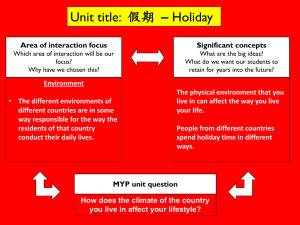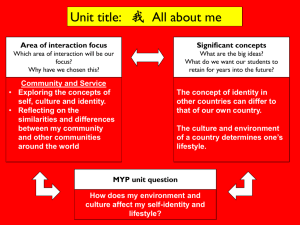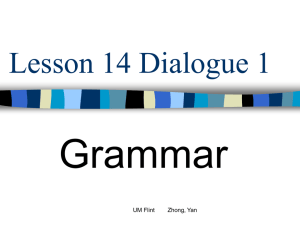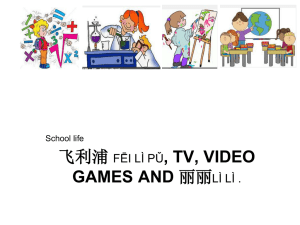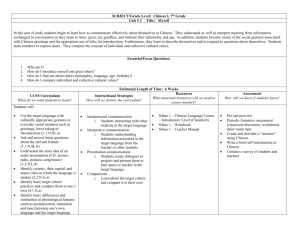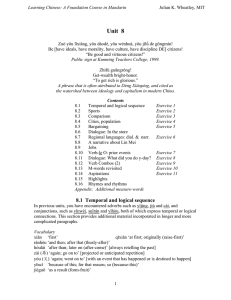ǀuyƗn ‘Smoking’ 10.12 Ch
advertisement
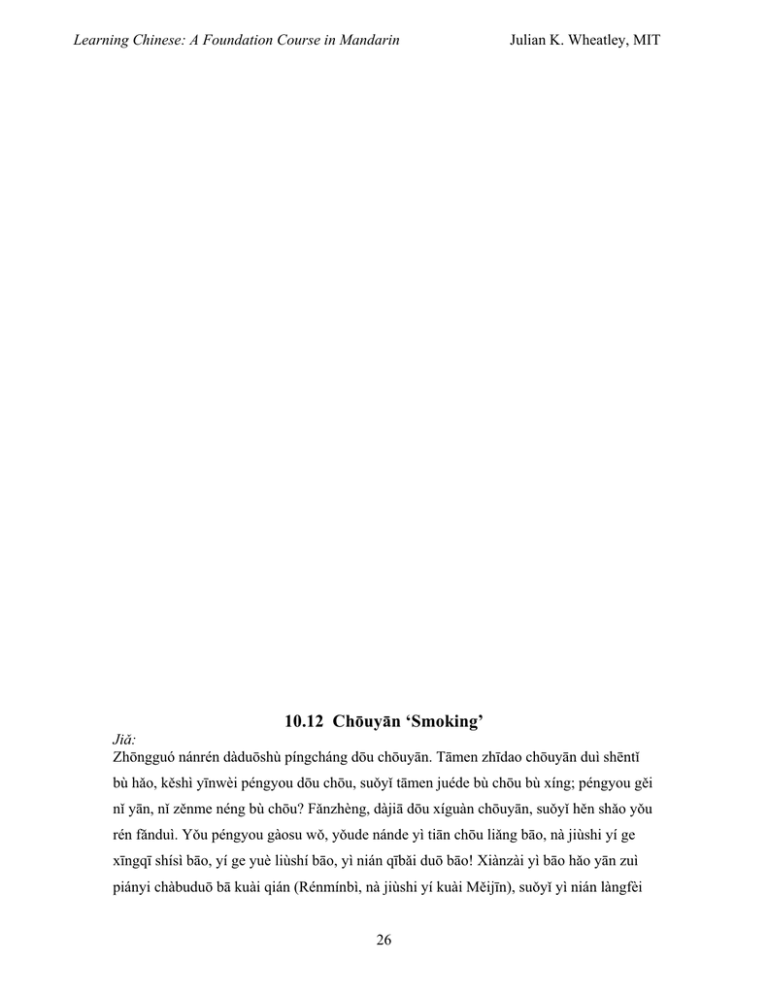
Learning Chinese: A Foundation Course in Mandarin
Julian K. Wheatley, MIT
10.12 ChǀuyƗn ‘Smoking’
Ji:
Zhǀngguó nánrén dàduǀshù píngcháng dǀu chǀuyƗn. TƗmen zhƯdao chǀuyƗn duì shƝntӿ
bù hӽo, kČshì yƯnwèi péngyou dǀu chǀu, suԁyӿ tƗmen juéde bù chǀu bù xíng; péngyou gČi
nӿ yƗn, nӿ zČnme néng bù chǀu? Fӽnzhèng, dàjiƗ dǀu xíguàn chǀuyƗn, suԁyӿ hČn shӽo yԁu
rén fӽnduì. Yԁu péngyou gàosu wԁ, yԁude nánde yì tiƗn chǀu liӽng bƗo, nà jiùshi yí ge
xƯngqƯ shísì bƗo, yí ge yuè liùshí bƗo, yì nián qƯbӽi duǀ bƗo! Xiànzài yì bƗo hӽo yƗn zuì
piányi chàbuduǀ bƗ kuài qián (Rénmínbì, nà jiùshi yí kuài MČijƯn), suԁyӿ yì nián làngfèi
26
Learning Chinese: A Foundation Course in Mandarin
Julian K. Wheatley, MIT
zhème duǀ qián, tài kČxƯ le! Zhǀngguó zuì yԁumíng de yƗncӽo gǀngsƯ zài YúnnánshČng,
zuì yԁumíng de páizi yČxԃ shi YúnyƗn, HóngtshƗn, hé Ɩshìm. JiƝ shàng, qìchƝ shàng,
nӿ huì kànjiàn hČn duǀ xiƗngyƗn de guӽnggào!
BČijƯng hútòngr de yƗntƗn (‘cigarette stand’).
Yԁurén chǀu Zhǀngguó yƗn, yČ yԁurén chǀu wàiguó yƗn, xiàng Wànbolù, Lètou
(Luòtuo). WàiguóyƗn dǀu bӿjiào gùi, yì bƗo chàbuduǀ shí duǀ kuài qián. SuƯrán hČn gùi,
kČshì chǀu wàiguó yƗn de yČ bù shӽo. TƯngshuǀ shi yƯnwèi wàiguó yƗn jìnr [jyèr] bӿjiào
dà. Xiànzài hČn duǀ Zhǀngguó rén yČ zhƯdao chǀu tài duǀ yƗn bù hӽo, kČshì chǀuyƗn de
rén háishi hČn duǀ. Nà, nӿ shuǀ MČiguó zČnmeyàng? ƿuzhǀu ne?
Y:
Wԁ xiƗn shuǀ MČiguó de qíngxing. Yӿqián zài MČiguó, chǀuyƗn de rén bìng bù shӽo.
Wԃshí niándài, liùshí niándài de diànyӿng-yӽnyuán bú shi lӽo chǀuyƗn ma? KČshì zuìjìn
èrshí duǀ nián lái, chǀuyƗn de hӽoxiàng yuèlái yuè shӽo. Wèishénme ne? Nà shì yƯnwèi
dàjiƗ dǀu zhƯdao chǀuyƗn duì shƝntӿ bù hӽo, chǀuyƗn de bӿjiào róngyì dé áizhèng. Suԁyӿ
xiànzài MČiguó hČn duǀ dìfang, xiàng jƯchӽng, huԁchƝzhàn, fànguӽnr, fàndiàn dČngdČng
bú ràng nӿ chǀuyƗn, mČi ge dìfang dǀu shuǀ: “Bù zhԃn xƯyƗn.” (XƯyƗn jiùshi chǀuyƗn de
yìsi, xƯyƗn nèi ge cí kČnéng bӿjiào zhèngshi, chǀuyƗn bӿjiào kԁuyԃ.) Nӿ kàn, MČiguó
zԁngtԁng chǀuyƗn ma? LígƝn (LéigƝn), KČlíndùn, Bùshí (fù-zӿ), zhìshӽo zài biérén
miànqián bù chǀu!
27
Learning Chinese: A Foundation Course in Mandarin
Julian K. Wheatley, MIT
Zài MČiguó chǀuyƗn de bӿjiào shӽo yČ shi yƯnwèi yƗn hČn gùi! Yì bƗo sì-wԃ kuài
qián (MČijƯn, nà jiùshi sƗn sìshí duǀ kuài Rénmínbì.) ƿuzhǀu ne, zài ƿuzhǀu yƗn gèng
guì, chǀuyƗn de méiyou yӿqián de nàme duǀ, kČshì kČnéng háishi bӿ MČiguó de duǀ
yìdiӽnr. Wԁ ne, wԁ zìjӿ bù chǀuyƗn, érqiČ cónglái méi chǀu-guo, dànshi biérén yào chǀu,
nà, wԁ jiù bú huì guӽn tƗmen. Wԁ de kànfӽ shì ‘bié guӽn xián shì’, xiӽng chǀu jiù chǀu
ba!
Notes:
dàduǀshù
N ‘the majority (big-many-number)’
xíguàn
N ‘habit; custom’; cf. xӿhuan, xƯwàng ‘hope’ fӽnduì
V ‘oppose; object’
làngfèi
V ‘waste (time, money, etc.)’ kČxƯ
V ‘pitiable; unfortunate’; cf. Tài kČxƯ le. ‘That’s too bad.’ yƗncӽo
‘tobacco (smoke grass)’; cf. chǀuyƗn, xƯyƗn ‘to smoke’
páizi
‘brand name’
jiƝ shàng
‘(street-on)’
xiƗngyƗn
‘cigarets (fragrant-tobacco)’
guӽnggào
N ‘advertisement’ (gàosu de gào) Wànbolù
‘Marlboro’
Lètou (Luòtuo) ‘Camel’
bìng
Adv. ‘really [not]’, before negatives: bìng bù piányi ‘not at all cheap’. yӽnyuán
N ‘actors (perform-people)’
zuìjìn èrshí duǀ nián lái ‘over the past 20+ years’ dé áizhèng
VO ‘get cancer’
zhԃn
V ‘permit’, usually negative; common on signs: bù zhԃn ‘forbidden to …’ zhèngshì
SV ‘formal’
kԁuyԃ
N ‘spoken language’; SV ‘be-colloquial’; hČn kԁuyԃ
zhìshӽo
Adv. ‘at least’ miànqián
Loc’n Noun: ‘in front of [someone]; before (face-front)’ érqiČ
N ‘moreover; in addition’ guӽn
V ‘take care of; deal with; run s/t’ bié guӽn xián shì ‘mind one’s own business (don’t concern sparetime-things)’
jìnr [jyer]
[colloquial] ‘strength; vigor’; = yԁu lìqi ‘have strength; vigor’ Nèi zhԁng yƗnyèr hČn yԁu jìnr!
Wԁ jƯntiƗn bù shnjfu, méi jìnr.
Nӿ kàn, nèi ge rén zhƝn yԁu jìnr.
Zhǀngguó de báijiԃ hČn yԁu jìnr.
That kind of tobacco [leaf] is very strong! I don’t feel well today, no strength. Look, that guy’s really strong. Chinese white liquor is really strong. 28
Learning Chinese: A Foundation Course in Mandarin
Julian K. Wheatley, MIT
Exercise 6
Explain that American beer is more expensive than Chinese beer, but that Chinese still
buy it. Budweiser, called BӽiwƝi in China, is getting more and more popular (pԃbiàn).
Explain that you don’t think it has as much flavor as Chinese brands like QƯngdӽo,
Shànghӽi or YànjƯng. So you always tell your Chinese friends that they should drink
Chinese brands, not imports! The same with cigarets. Chinese pay attention to [zhòngshì
(‘heavy-view)’] brands. American brands are well known, so they buy American brands.
They say that, in any case, American cigarets are stronger than Chinese cigarets and they
taste better. I can’t believe this is really the case!
_______________________________________________________________________
10.12.1 Smoking: a dialogue
A friend (Y)--college age--offers you (Ji) a cigarette; most males in China smoke and so
offering someone a cigarette is considered a friendly gesture, and is sometimes difficult to
refuse.
Jiӽ
Lái (yì) kƝ yƗn ba.
Have a cigarette.
Y.
Xièxie, w΅ bu chǀuyƗn.
No thanks, I don’t smoke.
Jiӽ
ZhƝnde bù chǀu a?
You really don’t smoke?
Y
ZhƝnde!
Really!
Jiӽ
Duì a, chǀuyƗn bù hӽo,
duì shƝntӿ bù hӽo.
Right, smoking’s not good,
it’s not good for you[r body].
Y
Zhǀngguó rén dǀu chǀuyƗn ma?
Do Chinese all smoke?
Jiӽ
Chàbuduǀ le, nánde dǀu chǀu, nԉde More or less, men all smoke,
women less so. You mind if I smoke?
bӿjiào shӽo. Wԁ chǀu, xíng ma?
Y
Xíng, xíng, méi guƗnxi.
Fine, fine, no problem.
Jiӽ
Hӽo, suƯrán duì shƝntӿ bù hӽo,
kČshì wԁ háishi dČi chǀu.
Good, although it’s not good
for me, I still have to smoke.
Y
Wèishénme?
How come?
Jiӽ
Péngyou gČi nӿ yƗn,
zČnme néng bù chǀu?
<If> friends give you cigarettes,
how can you not smoke?
Notes
lái
here ‘take (cause to come)’; cf. lái yì bƝi kƗfƝi.
29
Learning Chinese: A Foundation Course in Mandarin
Julian K. Wheatley, MIT
kƝ
M ‘stub of...’; kƝ is a measure word for cigarets and other similarly
shaped objects. Cigarets are sometimes counted with the measure words
zhƯ or gƝn, as well as kƝ.
zhƝnde Adv. ‘really’, a variant of zhƝn.
10.13 Driving
a) KƗichƝ
Wԁ bú huì kƗichƝ, kČshì wԁ hČn xiӽng kƗi, suԁyӿ xiànzài yԁu ge péngyou bƗng wԁ xué.
Wԁ de péngyou shuǀ kƗichƝ hČn róngyì, dànshi wԁ juéde kƗichƝ bìng bù róngyì.
Yԁushíhou wԁ juéde háishi bù kƗi hӽo; chƝ de wéixinj, bӽoxiӽn dǀu hČn guì; chéng lӿ
kƗichƝ hČn màn. Zài shuǀ, hӽo duǀ rén kƗichƝ kƗi+de tài kuài, kƗi+de hČn mČng! Lù
shàng hČn wƝixiӽn!
Bù jiԃ yӿqián zài Zhǀngguó, chƝ xiƗngdƗng guì, hƟn duǀ rén mӽibuqӿ, suǂyƱ lù shàng de
chƝzi bƱjiào shăo. Dànshi zuìjìn qíngxing biàn-le hƟn duǀ. Xiànzài chƝ bƱjiào piányi.
Guóchăn de xiànzài bӿ MƟiguó de piányi yìdiănr; Rénmínbì dàgài qƯbƗwàn jiu kƟyƱ mӽi yí
liàng. Jìnkǂu de dƗngrán bӿ guóchăn de guì hƟn duǀ, kƟshi jìnkǂu de yƟ shi yuèlái yuè
piányi. Tóngshí gƗosù-gǀnglù yƟ shi yì nián bӿ yì nián duǀ, suǂyƱ nƱ xiӽng kƗi dào shénme
dìfang dǀu xíng! Zhù zài chéngshì lӿtou de rén dàduǀshù xiӽngyào mӽi qìchƝ kƟyƱ mӽi
qìchƝ. Zài xiƗngxià qíngxing bù tóng, kƟshi nóngcnjn lӿtou de chƝzi háishi bӿ jӿ nián qián
duǀ deduǀ. KƟshi rúguǂ nƱ bù xiӽng huƗqián mӽi yí liàng chƝ nà, zài Zhǀngguó méi chƝ
yƟ méiyou guƗnxi. Wèishénme ne? YƯnwèi gǀnggòng jiƗotǀng hƟn hăo, yԁu gǀnggòng
qìchƝ, yԁu dìtiƟ, yԁu tiČlù. Zài MƟiguó, hƟn bù yíyàng: Méiyou chƝ hƟn bù fƗngbiàn –
kƟyƱ shuǀ ‘méi chƝ dČngyú méi tuƱ’. Zài MƟiguó méi chƝ jiu bù néng qù gòuwù zhǀngxƯn
măi dǀngxi, méi chƝ jiù bù néng qù kàn péngyou, bù néng qù kàn diànyƱngr, yƟ bù néng
qù shàngxué. Hăoxiàng zài MƟiguó méi chƝ shénme shì dǀu zuòbuliӽo.
Zài MČiguó yԁu hČn duǀ MČiguó páizi de chƝ, xiàng Fútè, Biékè, yČ yԁu ƿuzhǀu
de, xiàng Àodí, BƝnchí, yČ yԁu RìbČn de, xiàng FƝngtián, BČntián, Hánguó de xiàng
Xiàndài. Nà Zhǀngguó yČ yԁu hČn duǀ páizi. Zuì pԃbiàn de yČxԃ shi SƗngtnà Jiédá,
Biékè dČngdeng, kČshi jìnkԁu de yČ bù shӽo, yČ shi yuèlái yuè duǀ. Wԁ yČ tƯngshuǀ
Zhǀngguó de bӽiwàn-fùwƝng, tƗmen mӽi LáosƯláisƯ, shìjiè shàng zuì gùi de chƝ! Ai,
biànhuà zhƝn dà ya! Èrshíduǀ nián yӿqián, Zhǀngguó lӽobӽixìng yԁu zìxíngchƝ, yӿjing
30
Learning Chinese: A Foundation Course in Mandarin
Julian K. Wheatley, MIT
hČn mӽnyì le! Xiànzài shéi dǀu xƯwàng zìjӿ yԁu yí liàng qìchƝ. Búguò rúguԁ Zhǀngguó
mČi ge jiƗtíng dǀu yԁu yí liàng qìchƝ de huà, nà Zhǀngguó de jiƗotǀng qíngxing huì shi
shénme yàngzi de ne?
Bóchuán (‘barges’), zài Snjzhǀu de yùnhé.
b) Páizhào
Zài Zhǀngguó mӽi chƝ rénmén yídìng yào kàn chƝ de páizi; kƟshi chƝ nèi de kuӽnshì yƟ
hƟn zhòngyào. ShƝnfen bƱjiào gƗo de guƗnyuán huòzhƟ shƗngrén, tƗ de qìchƝ yídìng shì
pízuò, chƝchuƗng bǀli shi àn sè de (zhèi yàng wàibiƗn kànbujiàn lӿbiƗnr, kƟshi lӿbiƗnr
kàndejiàn wàibiƗnr). QìchƝ de páizhào yƟ hƟn zhòngyào. Páizhào shàng bìxnj yԁu jíxiáng
shùzì, xiàng bƗ (tƯngqӿlai xiàng fƗcái de fƗ) huòzhƟ sƗn (sƗn zài Guӽngdǀnghuà lƱ tƯngqӿlai
xiàng gƗoshƝng de shƝng de yìsi), bù yƯnggƗi yԁu bù jíxiáng de shùzì, bƱrú sì (tƯngqӿlai
xiàng sӿdiào de sӿ yíyàng). Zài shuǀ, yԁu shíhou cóng chƝ páizhào de hàomă kƟyƱ
kàndechnj rénjiƗ de shƝnfen.
Cóng shàngbiƗn shuǀ de wǂmen kƟyƱ zhƯdao Zhǀngguó rén tèbié zhùyì shƝnfen.
SuǂyƱ wǂmen qù Zhǀngguó de shíhou, yídìng yào zhùyì Zhǀngguó rén de shƝnfen wèntí,
tèbié shi zài chƝnghu tƗmen de shíhou.
31
Learning Chinese: A Foundation Course in Mandarin
Julian K. Wheatley, MIT
Liáoníng de páizhào.
Notes:
wéixinj
bӽoxiӽn
zài shuǀ
mČng
wéixiӽn
bù jiǎ
tóngshí
gƗosù-gǀnglù
nóngcnjn
huƗ qián
jiƗotǀng
tiČlù
fƗngbiàn
dČngyú
tuƱ
páizi
V ‘to maintain; keep up’
N ‘insurance’
‘moreover; what’s more’
SV ‘be wild’ SV ‘be dangerous’; N ‘danger’ ‘not long’ (cf. jiǎ ‘be long [of time]’)
‘at the same time’
N ‘expressways (high-speed public-road)’ N ‘villages; countryside’
VO ‘spend money’ N ‘transportation’
N ‘railways (iron-road)’
SV ‘convenient’
V ‘be equivalent to (equal-to)’ N ‘legs’
N ‘brand names’; cf. pӿnpái ‘trademark’
Fútè
Àodí
FƝngtián
Jiédá
SƗngtnà
LáosƯláisƯ
PN: ‘Ford’
Biékè
PN: ‘Buick’
PN: ‘Audi’
BƝnchí
PN: ‘Mercedes’
PN: ‘Toyota’
BČntián
PN: ‘Honda’
PN: ‘Volkswagon (Jetta)’
Xiàndài
PN: ‘Hyundai’
PN: car produced by a joint venture with VW
PN ‘Rolls Royce’
bӽiwàn-fùwƝng N: ‘millionaire (million wealthy-old man)’
N ‘changes (change-transformation)’
biànhuà
lӽobӽixìng
N ‘the ordinary people (old-hundred-surnames)’
mӽnyì
SV ‘satisfied; pleased’ shéi dǀu
N ‘everyone’
nèi
Loc ‘inside’; cf guónèi ‘within the country’; shìnèi ‘in town’ kuӽnshì
N ‘designs; styles’ zhòngyào
SV ‘be important’
shƝnfen
N ‘status’
32
Learning Chinese: A Foundation Course in Mandarin
guƗnyuán
shƗngrén
pízuò
chƝchuƗng
bǀli
àn
páizhào
jíxiáng
shùzi
fƗcái
gƗoshƝng
zhùyì
Julian K. Wheatley, MIT
N ‘officials’
N ‘businessmen’
N ‘leather seats’ N ‘car windows’ N ‘glass’
SV ‘be dark; dim’
N ‘license plates’ SV ‘lucky; auspicious’ N ‘numbers’
V ‘get rich’; cf. gǀngxӿ fƗcái, a Chinese New Year greeting
V ‘get a promotion (high-rise)’ V ‘pay attention to’ Exercise 7
Huídá (‘respond to’) wèntí:
1. Zài Zhǀngguó wèishénme yԁu rén bù xiӽng mӽi qìchƝ?
2. Xiànzài zài Zhǀngguó jiƗotǀng de qíngxing zƟnmeyàng?
3. Wèishénme shuǀ zài Zhǀngguó méiyou chƝ méiyou guƗnxi?
4. Wèishénme shuǀ zài MƟiguó bìxnj dČi yԁu qìchƝ?
5. Nà, zài ƿuzhǀu ne? Shì bu shì méiyou qìchƝ yƟ hƟn bù fƗngbiàn?
6. Zhǀngguó nČi xiƝ páizi de qìchƝ zuì liúxíng?
7. Zhǀngguó de lăobăixìng dǀu xiӽng mӽi qìchƝ de huà, nà jiƗotǀng de qíngxing huì
zƟnmeyàng?
8. Zhǀngguó rén chúle chƝ de páizi yӿwài yƟ huì zhùyì dào nƟi xiƝ fƗngmiàn ('facet')?
9. NƱ qù Zhǀngguó kànkan chƝ de páizhào huì fƗxiàn nƟi xiƝ fƗngmiàn bƱjiào yԁu yìsi?
10.14 Vivid SVs (of the form SVxx)
In earlier units, you have seen vivid adjectives formed from SV roots and repeated
syllables: huálinjlinj; huƯméngméng (~ mƝng). While some of the repeated syllables can be
matched with some confidence to independent words (eg bƯng ‘ice’ in lČngbƯngbƯng), for
others, the only indication of their source comes from the characters used to write them,
and these may have been chosen for their sound rather than their meaning. The repeated
sƯ in làsƯsƯ ‘hot; peppery’ is written with the character usually used for ‘silk’; lƗsnjsnj,
which has much the same meaning, contains the repeated syllable snj, written with the
character for ‘crisp’. It is hard to see what contribution these words make to the meaning
of the whole, other than filling out the pattern.
Most of the repeated syllables are level-toned. A number of them show variation,
probably due to the influence of the usual tone of the character chosen for the second
33
Learning Chinese: A Foundation Course in Mandarin
Julian K. Wheatley, MIT
syllable. The teng of rèténgténg for example, is often pronounced with a level tone even
though pedantic speakers are likely to argue, on the basis of the character ᄄ which in
other contexts is pronounced with rising tone, that rising (and not level) is the ‘correct’
tone. However, there are a few cases where the tone of the repeated syllable clearly is not
level, eg kǀngdàngdàng.
Vivid SVs of this type have certain grammatical properties that set them apart
from ordinary SVs. They cannot be modified by ‘adverbs of degree’ such as hČn or tài,
for example. Typically, they act as modifiers connected to nouns by a following de; or
they stand alone (still with following de) as commentaries; cf. examples below.
The list below gives an indication of the range of vivid SVs; the meaning of the
root SV is given in parentheses.
cháohnjhnj
(cháo ‘damp’)
damp; clammy
huálinjlinj
(huá ‘slippery’ )
slimy; slippery [of roads]; slick
[of hӽishƝn]
làsƯsƯ
(là ‘peppery hot’)
hot; peppery [food]
lètáotáo
(lè, cf. kuàilè ‘happy’)
happy [of children; life]
lČngbƯngbƯng
(lČng + bƯng ‘ice’)
icy cold [of iron, facial expressions]
hƝiyǀuyǀu
(hƝi ‘black’)
jet black [of hair, soil]
hóngtǀngtǀng
(hóng ‘red’)
glowing red; brilliant red
hóngpnjpnj
(hóng ‘red’)
reddish
luànhǀnghǀng
(luàn ‘chaotic’)
tumultuous
liàngjƯngjƯng
(liàng ‘bright’)
glimmering; sparklinig
mínghuƗnghuƗng
(míng ‘luminous’)
gleaming [metal]
nuӽnhǀnghǀng
(nuӽn ‘warm’)
cozy and warm
rèténgténg (~ tƝng)
(rè)
steaming hot [of buns, noodles]
rèhnjhnj
(rè)
piping hot [of a stove, heater]
rèhǀnghǀng
(rè)
very warm; boiling [of weather]
kǀngdàngdàng
(kǀng ‘empty’)
empty; deserted [of station, mall]
xiƗngpƝnpƝn
(xiƗng ‘fragrant’)
sweet smelling; savory; appetizing
wùméngméng(~ mƝng) (wù ‘fog’)
hazy, misty
34
Learning Chinese: A Foundation Course in Mandarin
Julian K. Wheatley, MIT
Usage
NƱmen niánqƯngrén jiu xiàng zăoshàng
bƗ-jiǎ diӽn zhǀng hóngtǀngtǀng de
tàiyáng yíyàng.
You young people look like the
glowing red sun at 8 or 9 in the
morning. [Said by Mao Zedong.]
NƱ kàn, tƗmen dǀu zài kàng shàng
zuò-zhe ne, nuӽnhǀnghǀng de.
Look at them all sitting on the
‘stove’, all cozy and warm.
Lái le, rèténgténg de jiӽozi!
Here they come! Piping hot
dumplings!
Notes
In houses in the cold northern parts of China, families sleep on a large brick
platform heated from within, known as a kàng.
35
MIT OpenCourseWare
http://ocw.mit.edu
21G.103 Chinese III (Regular)
Fall 2005
For information about citing these materials or our Terms of Use, visit: http://ocw.mit.edu/terms.
